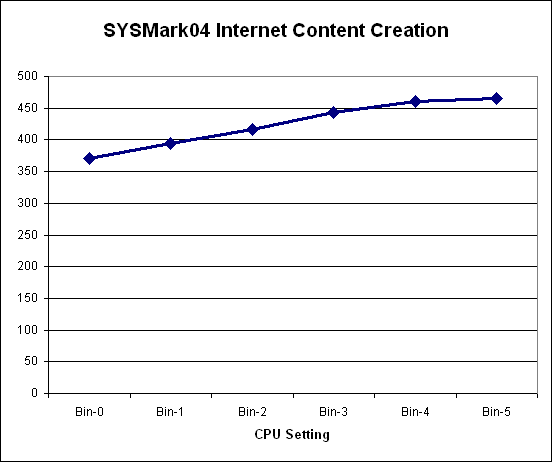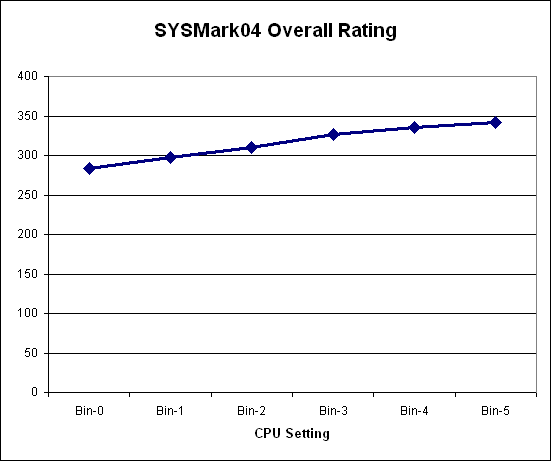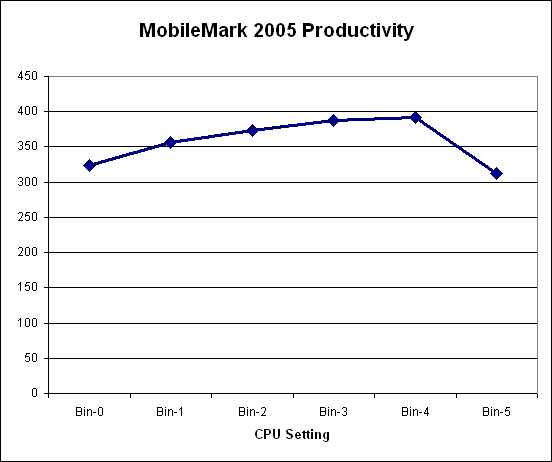Overclocking Performance - General Applications
We wanted to focus on the benefits of overclocking with the XPS M1710, so we'll start our performance results there. One of the first things we did when we received the notebook was to set the maximum overclock and begin stress testing, and after discovering that the system ran stable we didn't think there would be much need to test any of the other options. However, due to increased noise levels, temperatures, and periodic CPU throttling we decided it was necessary to test all six clock speed settings. We used a variety of commonly available benchmarks which we won't bother to describe here. If you need one more details about the benchmarks, feel free to ask in the comments section. Test settings for the games were generally maximum detail with 0xAA/8xAF and 4xAF where noted.





Starting with the general system performance benchmarks, we immediately get some interesting results. SYSmark 2004 appears to benefit at every clock speed increase up to the maximum, although the relative increase is less at the top two settings. Looking at the separate Internet Content Creation and Office Productivity results, the Internet Content Creation test suite hardly benefits at all with the final speed bump, whereas the Office Productivity results continue to scale well all the way through Bin-5. PCMark05 achieves its best performance at the Bin-3 setting, but MobileMark 2005 shows a serious drop off in performance at the maximum clock speed. We actually ran the MobileMark 2005 Productivity test several times at the Bin-5 setting just to verify the results, and we reported the best score out of the three individual test runs. The other two scores were 272 and 284.
The severe drop in performance in MobileMark 2005 may be a result of running on battery power, as it's possible the battery couldn't handle the load and the system was forced to reduce processor speed. This particular test represents the most severe drop in performance we measured at the maximum setting, and given the requirement that MobileMark run on battery power our conclusion for now is that users shouldn't overclock - especially to the maximum setting - if they aren't going to be plugged in. We would generally recommend that anyway, as the overclock settings are simply going to further reduce battery life and the system as it stands already has a relatively short mobile lifespan.
We wanted to focus on the benefits of overclocking with the XPS M1710, so we'll start our performance results there. One of the first things we did when we received the notebook was to set the maximum overclock and begin stress testing, and after discovering that the system ran stable we didn't think there would be much need to test any of the other options. However, due to increased noise levels, temperatures, and periodic CPU throttling we decided it was necessary to test all six clock speed settings. We used a variety of commonly available benchmarks which we won't bother to describe here. If you need one more details about the benchmarks, feel free to ask in the comments section. Test settings for the games were generally maximum detail with 0xAA/8xAF and 4xAF where noted.





Starting with the general system performance benchmarks, we immediately get some interesting results. SYSmark 2004 appears to benefit at every clock speed increase up to the maximum, although the relative increase is less at the top two settings. Looking at the separate Internet Content Creation and Office Productivity results, the Internet Content Creation test suite hardly benefits at all with the final speed bump, whereas the Office Productivity results continue to scale well all the way through Bin-5. PCMark05 achieves its best performance at the Bin-3 setting, but MobileMark 2005 shows a serious drop off in performance at the maximum clock speed. We actually ran the MobileMark 2005 Productivity test several times at the Bin-5 setting just to verify the results, and we reported the best score out of the three individual test runs. The other two scores were 272 and 284.
The severe drop in performance in MobileMark 2005 may be a result of running on battery power, as it's possible the battery couldn't handle the load and the system was forced to reduce processor speed. This particular test represents the most severe drop in performance we measured at the maximum setting, and given the requirement that MobileMark run on battery power our conclusion for now is that users shouldn't overclock - especially to the maximum setting - if they aren't going to be plugged in. We would generally recommend that anyway, as the overclock settings are simply going to further reduce battery life and the system as it stands already has a relatively short mobile lifespan.










20 Comments
View All Comments
Gary Key - Tuesday, May 8, 2007 - link
It is a typo on the chart. The numbers reflected are the total score, not the individual break out on FPS.
JarredWalton - Tuesday, May 8, 2007 - link
Fixed. SupCom is a generated score from the perftest map (with an edited benchmark script). Sorry about that.yacoub - Tuesday, May 8, 2007 - link
what?Article says:
"We weren't able to run our latest gaming benchmarks (S.T.A.L.K.E.R. and Supreme Commander) on all of the laptops, so performance results for those games won't be included here."
JarredWalton - Tuesday, May 8, 2007 - link
The XPS M1710 OC scaling charts included SupCom and STALKER results. Just not the other laptops (although I might be able to run the benchmarks on a couple laptops still).yacoub - Tuesday, May 8, 2007 - link
I gave up on waiting for laptops to reach reasonable prices. Ordered a nice c2d setup to replace my aging A64 rig and did it for under $425. CPU, RAM, and Mobo. My 7900GT is still enough for now, but when the 8800GTS 640MB hits $350 without rebates I'll probably scoop one of those up too. So still under $800 for a full system upgrade.And since I can remote in to my home machine from work and my work machine from home, I really have little need for a laptop, though I do have a company-provided laptop for travel if I really needed to use it. On that flash games (tower defense, etc) are enough to keep me entertained if I'm that desperate to sit in a hotel room(?!). Most likely an mp3 player or a book is all I need in-flight and I'll be out doing things (business or tourist related) when I'm traveling so uber high-end gaming laptops at exorbitant prices just don't really have a use for me, or I'd imagine for most folks.
Ender17 - Tuesday, May 8, 2007 - link
The graphs would be a lot easier to read if they were labeled with the actual CPU speed instead of Bin 1, Bin 2...redbone75 - Tuesday, May 8, 2007 - link
Agreed. Just as easy to put 2.33 - 3.16 as it is to do Bin-0 - Bin-5. Actually, you save a character :)JarredWalton - Tuesday, May 8, 2007 - link
Given that the clock speeds are more of a request than an actual result, I didn't want to use those. I couldn't actually see if throttling was occurring during the game benchmarks, but the scores seem to indicate that the CPU was throttling at the Bin-4 and Bin-5 results on some games.The names I used came from discussions with Dell, where they referred to the clock speeds as "Bin + 3", but I used a plus sign instead. Given that the scores are all pretty close on many benchmarks, I didn't think too much about it.
Zsuu - Saturday, February 21, 2015 - link
Good looking Dell <a href="http://www.lapt0p-hu.eoldal.hu/">notebook&...Zsuu - Monday, February 23, 2015 - link
These laptop is very good http://www.lapt0p-hu.eoldal.hu/